
James Fintan Lalor
Encyclopedia

Irish language
Irish , also known as Irish Gaelic, is a Goidelic language of the Indo-European language family, originating in Ireland and historically spoken by the Irish people. Irish is now spoken as a first language by a minority of Irish people, as well as being a second language of a larger proportion of...
, Séamas Fionntán Ó Leathlobhair) (March 10, 1807 – December 27, 1849) was an Irish revolutionary, journalist, and “one of the most powerful writers of his day.” A leading member of the Irish Confederation (Young Ireland), he was to play an active part in both the Rebellion in July 1848 and the attempted Rising in September of that same year. Lalor’s writings were to exert a seminal influence on later Irish leaders such as Michael Davitt
Michael Davitt
Michael Davitt was an Irish republican and nationalist agrarian agitator, a social campaigner, labour leader, journalist, Home Rule constitutional politician and Member of Parliament , who founded the Irish National Land League.- Early years :Michael Davitt was born in Straide, County Mayo,...
, James Connolly
James Connolly
James Connolly was an Irish republican and socialist leader. He was born in the Cowgate area of Edinburgh, Scotland, to Irish immigrant parents and spoke with a Scottish accent throughout his life. He left school for working life at the age of 11, but became one of the leading Marxist theorists of...
, Pádraig Pearse, and Arthur Griffith
Arthur Griffith
Arthur Griffith was the founder and third leader of Sinn Féin. He served as President of Dáil Éireann from January to August 1922, and was head of the Irish delegation at the negotiations in London that produced the Anglo-Irish Treaty of 1921.-Early life:...
.
Early life
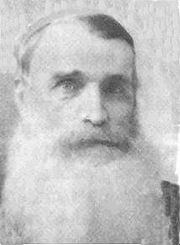
Raheen
Raheen is a suburban district of southwestern Limerick City, Ireland. It houses the headquarters of the Mid-Western Region of the Health Service Executive so that a multitude of essential health services catering for the population of the region are dispensed from this suburban...
, County Laois
County Laois
County Laois is a county in Ireland. It is part of the Midlands Region and is also located in the province of Leinster. It was formerly known as Queen's County until the establishment of the Irish Free State in 1922. The county's name was formerly spelt as Laoighis and Leix. Laois County Council...
, known at the time as Maryborough, Queen's County on the 10 March 1807. The first son of Patrick and Anna Lalor (née Dillon of Ards, County Offaly, at the time called King's County). Patrick and Anna were to have twelve children. Patrick was to become the first Catholic M.P. for Laois in 1832 - 1835, and was to lead a campaign of passive resistance to the payment tithes. Patrick was to out live his eldest son by six years, dying in 1856, and his mother Anna was to die in 1835, the same year as his brother Joseph.
James was, according to Tomás Ó Néill one of his biographers, a fine healthy baby when born, but as the result of an accident as an infant, was left semi-crippled. Though small for his age, being both pale and delicate, James was to display unexpected strength of body. Though hardy enough he was never sent to school, having private tuition at home instead. This was to continue up until he was seventeen, when it was then decided that he should go to college.
St Patrick's, Carlow College
In February 1825 he went to St. Patrick's, Carlow CollegeSt. Patrick's, Carlow College
St Patrick's, Carlow College, founded in 1782 by Dr James Keefe, then Roman Catholic Bishop of Kildare and Leighlin, and his co-adjutor Bishop Daniel Delany, and opened in 1793, is a college in Carlow, Ireland. Initially he attempted to open a seminary in Tullow, but instead took out a 999 year...
, the Vice-President of which, Father William Kinsella, was to go on to become the bishop of Ossory
Bishop of Ossory
The Bishop of Ossory is an episcopal title which takes its name after the ancient of Kingdom of Ossory in the Province of Leinster, Ireland. In the Roman Catholic Church it remains a separate title, but in the Church of Ireland it has been united with other bishoprics.-History:The diocese of Ossory...
. It was Father William himself who welcomed James to the college and introduced him to Maurice Lenihan, who was to be his advisor and guardian. In College James studied both chemistry, under a Mr. Holt and the classics under Father Andrew Fitzgerald
Andrew Fitzgerald
Father Andrew Fitzgerald O.P, a native of Kilkenny, he was a professor at St. Patrick's College, Carlow where he taught classics, he was chair of divinity....
. While in college he became a member of the Apollo Society, were literature and music were studied, his favourite author at the time being Lord Bolingbroke.
In college one of the great influences on James was Bishop James Doyle. In the controversies over tithes
Tithe War
The Tithe War was a campaign of nonviolent civil disobedience, punctuated by sporadic violent episodes, in Ireland between 1830-36 in reaction to the enforcement of Tithes on subsistence farmers and others for the upkeep of the established state church - the Church of Ireland...
, education and the freedom of religion
Freedom of religion
Freedom of religion is a principle that supports the freedom of an individual or community, in public or private, to manifest religion or belief in teaching, practice, worship, and observance; the concept is generally recognized also to include the freedom to change religion or not to follow any...
Dr. Doyle, writing under the pen name J.K.L, was considered very influential. An atmosphere of patriotism in the college was encouraged, and this was shown later, not just in James Fintan’s later life, but in that of students such as John O'Leary
John O'Leary
John O'Leary may refer to:* John O'Leary , Irish nationalist who was imprisoned in England during the nineteenth century*John O'Leary , former Irish Fianna Fáil party politician and TD for Kerry South...
, Richard D'Alton Williams
Richard D'Alton Williams
Richard D'Alton Williams was an Irish physician and poet, "Shamrock" of the Nation.-Life:He was born in Dublin, son of Count D'Alton and Mary Williams. He was educated at Tullabeg Jesuit College and St. Patrick's College, Carlow.He came to Dublin in 1843 to study medicine. He started contributing...
and Maurice Leyne.
While in college James worked hard and learnt the basics and principles not just of chemistry but law also. This understanding of law, Tomás Ó Néill suggests became evident from his writings later on. He suffered greatly through ill health during his time in college, and in February 1826, being ill and very weak he had to return home.
After College
Not much is known about James after he left college, most information being based on oral tradition. One suggestion is that he became an apprentice to a Dr. John Jacob, who worked in Portlaoise county hospital. In the June 1827 Dr. Jacob died and was replaced by his son who was a young medical student. The suggestion is that they did not get on and James left the hospital. Another account put forward for this period is that he left the hospital because of a "disappointment in love.” It is then suggested that James intended to sail to France. Tomás Ó Néill is fairly certain that James never went to France, and points to the fact that there is no reference to it in James later writings.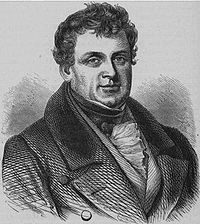
Tithe Campaign
Catholic Emancipation had been granted in 1829, and according to Patrick Lalor, Catholics would never be fully free while the burden of a foreign faith was on them in the form of tithes. Supported by his family, Patrick at a public meeting in Portlaoise, said he intended to give up paying tithes to a foreign faithChurch of England
The Church of England is the officially established Christian church in England and the Mother Church of the worldwide Anglican Communion. The church considers itself within the tradition of Western Christianity and dates its formal establishment principally to the mission to England by St...
. As a result of this declaration, Arthur Moore Mosse, who was the secretary of the Grand Jury, asked Patrick to call off his campaign offering to give him a receipt for the year's tithe, but this he refused. Mosse then offered him a receipt that would free him from tithes for the rest of his life, and this was also refused.
Shortly after, the proctor seized twenty of the brothers' sheep, but they got replevin and the sheep had to be returned. When the sheep had to be sold the family painted "Tithe" on them, which meant no-one would buy them. On the way to Smithfield market in Dublin no-one would offer any help to the drovers. In Dublin the only bid for them was from the steward of the Rev. John Latouch, a Mr. Brough. It was Latouch who had sent the proctor to the Lalors in the first place. As a result of this the sheep had to be placed on a boat for Liverpool, but even there no-one would bid for them, so they were then driven to Manchester and then to Leeds: most died on the road.
The Lalor brothers had through their father become politically active. (The Tithe War
Tithe War
The Tithe War was a campaign of nonviolent civil disobedience, punctuated by sporadic violent episodes, in Ireland between 1830-36 in reaction to the enforcement of Tithes on subsistence farmers and others for the upkeep of the established state church - the Church of Ireland...
had started according to O'Neill, but it would be some time before it would end.)
Politics
.jpg)
Daniel O'Connell
Daniel O'Connell Daniel O'Connell Daniel O'Connell (6 August 1775 – 15 May 1847; often referred to as The Liberator, or The Emancipator, was an Irish political leader in the first half of the 19th century...
's Repeal Association. Founding himself the Laois Liberal Club, which was in later year’s part of the election machinery for Parnell. During the elections of this year, Patrick was to come in ahead of Sir Charles Coote, the Tory Party candidate winning the seat, and this was seen as a major victory to the cause. During the campaign the Tory paper, the Leinster Express, attempted to destroy Patrick’s character, claiming he himself was a tyrant. Patrick was in 1835 to lose his seat to Thomas Vesey, the son of Lord Vesey. Lord Vesey during the election compelled his tenants to vote against their conscience, and those who did not were evicted from their holdings.
Around this time there were a number of secret societies in Ireland. With names such as the Blackfeet, Whitefeet and the Terryalts. These groups originated from the Whiteboys of the previous generation. It was these groups who reacted to these type of evictions. James was of the view the root of the problem lay not with the societies but with the power of the landlords to evict tenants. Lalor’s great friend at this time was John Marnell, also the son of a farmer, and he too shared Lalor's views. It was the issue of land and the ownership of land which was to shape the rest of James Fintan Lalor’s life.
Temperance and The Shamrock Friendly Society
_-_project_gutenberg_etext_13103.jpg)
Theobald Mathew (temperance reformer)
Theobald Mathew , an Irish teetotalist reformer, popularly known as Father Mathew was born at Thomastown, near Golden, County Tipperary, on October 10, 1790....
the temperance priest began his campaign. In just a year or two of starting this campaign millions were to give up alcohol. One such society was formed in Raheen and Fintan Lalor became a member. In the November 1840 he then proposed that the Society should become an association and that it should have additional aims also. This was agreed and the name was changed to The Shamrock Friendly Society. In this Society they planned to organise free legal aid to help the poor, as well as organise reading and promote healthy games.
In addition to the Society, Fintan Lalor was influenced by a group of agrarian reformers in his native county. They were led by William Conner, who suggested a scheme for arbitration on rents and fixity of tenure for tenant farmers. Conner’s suggestions were to find few supporters, but Fintan Lalor was one of them. He became closely associated with Conner and spent weeks at his house near Athy. He also attended Conner’s public meetings which were held in various parts of Kildare and Laois.
Conner was finally charged with making a seditious speech at Mountmellick in 1841 for which he received a sentence of six months’ imprisonment. As a result of his activities Conner was expelled from the Repeal Association because he proposed that Repealers should not pay rent, county cess, rent charge, tithe poor rate or any other charge arising out of land until repeal was granted. Fintan Lalor agreed with Conner and it was at this stage that his political differences with his Father really began.
Repeal Association
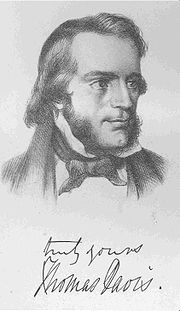
Daniel O'Connell
Daniel O'Connell Daniel O'Connell Daniel O'Connell (6 August 1775 – 15 May 1847; often referred to as The Liberator, or The Emancipator, was an Irish political leader in the first half of the 19th century...
split with the Whigs
British Whig Party
The Whigs were a party in the Parliament of England, Parliament of Great Britain, and Parliament of the United Kingdom, who contested power with the rival Tories from the 1680s to the 1850s. The Whigs' origin lay in constitutional monarchism and opposition to absolute rule...
and formed the Repeal Association
Repeal Association
The Repeal Association was an Irish mass membership political movement set up by Daniel O'Connell to campaign for a repeal of the Act of Union of 1800 between Great Britain and Ireland....
. While support for another one of O'Connell's associations was slow to start, with the adhesion of both Thomas Davis
Thomas Osborne Davis (Irish politician)
Thomas Osborne Davis was a revolutionary Irish writer who was the chief organizer and poet of the Young Ireland movement.-Early life:...
and John Blake Dillon
John Blake Dillon
John Blake Dillon was an Irish writer and Politician who was one of the founding members of the Young Ireland movement....
the Association was to quickly developed. James was totally opposed to both O’Connell and the Association. He thought O’Connell’s whole policy was flawed, and wrote a letter to Robert Peel
Robert Peel
Sir Robert Peel, 2nd Baronet was a British Conservative statesman who served as Prime Minister of the United Kingdom from 10 December 1834 to 8 April 1835, and again from 30 August 1841 to 29 June 1846...
the head of government, calling for it to be suppressed.
See Full text here: s:Letter to Robert Peel calling for Repeal to be suppressed
This opinion of O’Connell was to cause a rift to develop between Fintan Lalor and his father, who much admired O’Connell. The final event being an article Fintan Lalor was to write in January 1844 about the aims of the Irish agricultural Society. As a result of this their relationship was to break down completely, and Fintan Lalor was obliged to leave home.
Dublin and Belfast
Having left home Fintan Lalor headed to Dublin. While in the capitol his health deteriorated and was to break down completely. Thomas Brady attended to him, and treated him for a chest complaint. Based on the medication procribed, O’Neill suggests that it seems likely that what he was suffering from was tuberculosis. Fintan Lalor was to never fully recover from this episode.When his father found out about his sons condition, he sent money to help him out. Though he could have returned home at this time, he went instead to look for employment. His friend John Marnell introduced him to William Blood, who ran a bank come pawn shop, were the poor could get loans at reasonable rates. Fintan Lalor then went to Belfast to learn more about this from a similar establishment run by a Father James Finn.
He took ill again, at one stage vomiting blood, and on the advice of his family and friends was urged returned home to Tenakill. He wrote to his father and apologized for his many faults. As a result, the bonds between the two were mended.
Fintan Lalor, did not return home though, instead staying in the city and attempted to find employment. But his health was again to break down and at last he was forced to return home. By march 1846, he was back with his family in Tenakill.
The Nation
The Great Irish Famine led him into direct action: he attempted to found tenant-right societies and organise rent strikeRent strike
A rent strike is a method of protest commonly employed against large landlords. In a rent strike, a group of tenants come together and agree to refuse to pay their rent en masse until a specific list of demands is met by the landlord...
s.
.jpg)
The Nation (Irish newspaper)
The Nation was an Irish nationalist weekly newspaper, published in the 19th century. The Nation was printed first at 12 Trinity Street, Dublin, on 15 October 1842, until 6 January 1844...
". Writing from Tenakill, his family home, Fintan Lalor put forward his views on current affairs and in particularly on land reform. His manner and style of writing quickly caught the attention of both its readers and staff. T. F. O’Sullivan commented that “the journal realise that a new force had arisen in the political world.”
In the first letter, Fintan Lalor stated that contrasted with the question of the land, Repeal “was a petty, parish question.” On this he was quite emphatic “I will never contribute one shilling, or give my name, heart or hand for such an object as the simple Repeal.”
Commenting on the Irish Confederation, which was about to be formed he advocated that its policy should be one of “national independence.” He then proceeded to outline the policy he would approve on obtaining independence, “in what form of words you please; but denounce nothing—proscribe nothing, more especially of your own freedom of action. Leave yourselves free individually and collectively.” He continued “if any resolution, or pledge, be adopted to seek Legislative independence by moral force and legal proceedings alone, with a denunciation, or renunciation of all or any other means or proceedings, you may have millions better and stronger men than I to join you; but you won’t have me. . . . There has already, I think, been too much giving in on this question of means and force.”
He wrote again another letter on 19 April on the association between landowner and occupiers. Addressing himself to the landlords Fintan Lalor stated that “Ireland demanded more than her present dole of bread… Her demand was for a new Constitution…”
In his third letter titled “Tenants’ Rights” and “Landlord Law,” he addressed the subject of the famine. “Famine, more or less, was in 500,000 families—famine with all its diseases and decay; famine, with all its fears and horrors; famine, with all its dreadful pains and more dreadful debility. All pined and wasted, sickened and drooped; numbers died—the strong man, the fair maiden, the infant—the landlord got his rent… The 8,000 individuals who are owners of Ireland by divine right and the grant of God, confirm (by themselves) in sundry successive acts of parliament have a full view of these coming results [i.e. Ireland would become a pasture ground once gain. and its agricultural population would decay or vanish and become extinct at once] and have distinctly declared their intention of serving notice to quit on the people of Ireland…The landlords have adopted the process of depopulating the island and are pressing it forward to their own destruction, or to ours…” Fintan Lalor’s view was that the Landlords were “enforcing self-defence on us.”
In the September 1847, Fintan Lalor, along with Michael Doheny, organised at Holycross, in County Tipperary, for the purpose of putting forward his views on land reform. The meeting was failed to produce the results he wanted. Lacking both eloquence as a public speaker, and his weak state of health also rendered him unfit to conduct a public campaign.
The Irish Felon
John MitchelJohn Mitchel
John Mitchel was an Irish nationalist activist, solicitor and political journalist. Born in Camnish, near Dungiven, County Londonderry, Ireland he became a leading member of both Young Ireland and the Irish Confederation...
one of the Confederation
Irish Confederation
The Irish Confederation was an Irish nationalist independence movement, established on 13 January 1847 by members of the Young Ireland movement who had seceded from Daniel O'Connell's Repeal Association. Historian T. W...
leaders, was very impressed by Lalor’s views on land reform, and in a letter to William Smith O'Brien
William Smith O'Brien
William Smith O'Brien was an Irish Nationalist and Member of Parliament and leader of the Young Ireland movement. He was convicted of sedition for his part in the Young Irelander Rebellion of 1848, but his sentence of death was commuted to deportation to Van Diemen's Land. In 1854, he was...
himself the leader of the Confederation, said of him “Mr. Lalor, …does not now go for the whole of his system, but contemplates violent pressure on the landlords of those districts to coerce them into a fair settlement of the tenure question; the coercion to take the form of non-payment to such landlords as hold out.” A policy Mitchel was later to adopt.
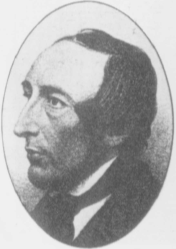
United Irishman
The United Irishman title has been a very popular newspaper title in Ireland and a number of newspapers have been published under the title.*...
, and the transportation of Mitchel.
Among some of the titles were “What must be Done,” “The Faith of a Felon,” “Resistance,” his final one being “Clearing Decks,” on the 22 July 1848. T. F. O’Sullivan was to describe Fintan Lalor writing as “powerful” of which three were included later in the indictment against, Martin for Treason Felony. Fintan Lalor responding to the indictment wrote to the Under Secretary, and took responsibility for the articles, and asked that the charges against Martin be dropped, stating that he would take responsibility. This was refused and Martin was, like Mitchel transported. This prompted the following response from Fintan Lalor
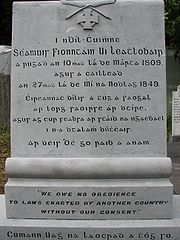
In another letter in the Irish Felon titled “The First Step—The Felon Club,” which was published on the 1 July, Lalor addressing the Government wrote “We hold the present existing government of this island and all existing rights of property in our soil, to be mere usurpation and tyranny, and to be null and void as of moral effect; and our purpose is to abolish them entirely, or lose our lives in the attempt. The right founded on conquest and affirmed by laws made by the conquerors themselves, we regard as no other than the right of the robber on a larger scale. We owe no obedience to laws enacted by another nation without our consent, nor respect to assumed rights of property which are starving and exterminating our people…” Outlining his intentions he wrote
“We have determined to set about creating, as speedily as possible, a military organisation, of which the Felons office shall be the centre and citadel. As a first step of proceeding, we are now founding a Club which, it is intended, shall consist of one, two or more persons from each parish throughout Ireland who are to be in immediate connection and correspondence with this office. . . . A prospectus and set of rules are in preparation, which we will publish when completed. But without waiting for such publication, we earnestly request every man in Ireland who desires to enrol himself as a colleague and comrade, and as a member of the Felon Club, will signify his wish by letter to the provisional secretary, Mr. Joseph Brenan, Felon office, 12 Trinity Street.”
In his last article for the Irish Felon “Clearing Decks,” Lalor wrote —“Remember this—that somewhere and somehow, and by somebody, a beginning must be made. Who strikes the first blow for Ireland? Who draws first blood for Ireland? Who wins a wreath that will be green forever?”
Arrest and Rising
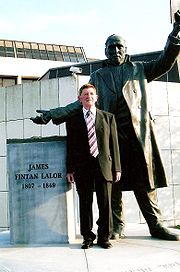
“His spirit, however, was undaunted,” according to O’Sullivan, and in the following year he set about organising a revival of the insurrection” in co-operation with John Savage
John Savage (Fenian)
John Savage was a poet, journalist and author. A member of both the Young Irelanders and the Fenians.-Early life:...
, Joseph Brennan
Joseph Brenan (Young Irelander)
Joseph Brenan was a poet, journalist and author. A leading member of the Young Irelanders and Irish Confederation.-Early life:...
, John O'Leary
John O'Leary (poet)
John O'Leary was an Irish separatist and a leading Fenian. He studied both law and medicine but did not take a degree and for his involvement in the Irish Republican Brotherhood he was imprisoned in England during the nineteenth century.-Early life:Born in the town of Tipperary, County Tipperary,...
and Thomas Clarke Luby
Thomas Clarke Luby
Thomas Clarke Luby was an Irish revolutionary, author, journalist and one of the founding members of the Irish Republican Brotherhood.-Early life:...
in Tipperary
Tipperary
Tipperary is a town and a civil parish in South Tipperary in Ireland. Its population was 4,415 at the 2006 census. It is also an ecclesiastical parish in the Roman Catholic Archdiocese of Cashel and Emly, and is in the historical barony of Clanwilliam....
and Waterford
Waterford
Waterford is a city in the South-East Region of Ireland. It is the oldest city in the country and fifth largest by population. Waterford City Council is the local government authority for the city and its immediate hinterland...
. At Cappoquin
Cappoquin
Cappoquin, also spelt Cappaquin or Capaquin , is a small town in west County Waterford, Ireland. It is on the Blackwater river at the junction of the N72 national secondary road and the R669 regional road. It is positioned on a sharp 90 degree bend in the river and nestles at the foot of the...
, in September, Savage and Brenan attacked the police barracks but the other leaders had not sufficient forces at their command to take aggressive action in the districts in which they were working, and the insurgents had to separate.
Three months afterwards, on 27 December 1849, Lalor died in his 43rd year, as a result of an attack of bronchitis, and was buried in Glasnevin.
Memorial
The James Fintan Lawlor Commemorative Committee, chaired by David Lawlor was formed in August 2005 to erect a memorial to mark the 200th anniversary of the birth of James Fintan Lalor. €110,000 was raised; Laois County Council provided the site; Irish Life and PermanentIrish Life and Permanent
Irish Life and Permanent, Plc or IL&P is a provider of personal financial services in Ireland. IL&P enjoys limited liability....
sponsored the project; the Department of the Environment provided half the cost
Matching donations
A matching gift, also known as a matching fund or matching donation is a charitable gift made toward a non-profit organization by a matching donor under the provision that an original donor first makes a gift toward that organization.-Typical procedure:As an example scenario, an employee of a...
. The bronze statue of Lalor holding a pamphlet aloft was sculpted by Mayo-based artist Rory Breslin. The inscription on the limestone plinth reads:
Family
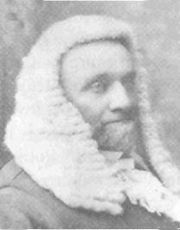
Young Ireland
Young Ireland was a political, cultural and social movement of the mid-19th century. It led changes in Irish nationalism, including an abortive rebellion known as the Young Irelander Rebellion of 1848. Many of the latter's leaders were tried for sedition and sentenced to penal transportation to...
er who later supported Parnell
Charles Stewart Parnell
Charles Stewart Parnell was an Irish landowner, nationalist political leader, land reform agitator, and the founder and leader of the Irish Parliamentary Party...
. He was an M.P for Queen's County
Queen's County (UK Parliament constituency)
Queen's County was a UK Parliament constituency in Ireland, returning two Members of Parliament 1801–1885 and one in 1918–1922.-Boundaries:This constituency comprised the whole of Queen's County now known as County Laois, except for the Parliamentary borough of Portarlington 1801–1885.- MPs...
from 1880 until 1892. He died in the family home in November 1893.
Peter
Peter Lalor
Peter Fintan Lalor was an activist turned politician who rose to fame for his leading role in the Eureka Rebellion, an event controversially identified with the "birth of democracy" in Australia.- Early life and migration to Australia :...
(1827–1889), James' youngest brother, went to Melbourne
Melbourne
Melbourne is the capital and most populous city in the state of Victoria, and the second most populous city in Australia. The Melbourne City Centre is the hub of the greater metropolitan area and the Census statistical division—of which "Melbourne" is the common name. As of June 2009, the greater...
in the colony of Victoria, Australia
Australia
Australia , officially the Commonwealth of Australia, is a country in the Southern Hemisphere comprising the mainland of the Australian continent, the island of Tasmania, and numerous smaller islands in the Indian and Pacific Oceans. It is the world's sixth-largest country by total area...
in 1852. In 1854 Peter led immigrant gold miners in an armed uprising at the Eureka Stockade
Eureka Stockade
The Eureka Rebellion of 1854 was an organised rebellion by gold miners which occurred at Eureka Lead in Ballarat, Victoria, Australia. The Battle of Eureka Stockade was fought on 3 December 1854 and named for the stockade structure erected by miners during the conflict...
, Ballarat going on to became a Member of the Victorian Legislative Assembly
Victorian Legislative Assembly
The Victorian Legislative Assembly is the lower house of the Parliament of Victoria in Australia. Together with the Victorian Legislative Council, the upper house, it sits in Parliament House in the state capital, Melbourne.-History:...
(1856–1887) and ministerial posts including Speaker
Speaker of the Victorian Legislative Assembly
The Speaker of the Victorian Legislative Assembly is the presiding officer of the Victorian Legislative Assembly, the lower house of the Parliament of Victoria....
in 1880.
Sources
Additional Reading- The Politics of Irish Literature: from Thomas Davis to W.B. Yeats, Malcolm Brown, Allen & Unwin, 1973.
- John Mitchel, A Cause Too Many, Aidan Hegarty, Camlane Press.
- Thomas Davis, The Thinker and Teacher, Arthur Griffith, M.H. Gill & Son 1922.
- Brigadier-General Thomas Francis Meagher His Political and Military Career,Capt. W. F. Lyons, Burns Oates & Washbourne Limited 1869
- Young Ireland and 1848, Dennis Gwynn, Cork University Press 1949.
- Daniel O'Connell The Irish Liberator, Dennis Gwynn, Hutchinson & Co, Ltd.
- O'Connell Davis and the Collages Bill, Dennis Gwynn, Cork University Press 1948.
- Smith O’Brien And The “Secession”, Dennis Gwynn,Cork University Press
- Meagher of The Sword, Edited By Arthur Griffith, M. H. Gill & Son, Ltd. 1916.
- Young Irelander Abroad The Diary of Charles Hart, Edited by Brendan O'Cathaoir, University Press.
- John Mitchel First Felon for Ireland, Edited By Brian O'Higgins, Brian O'Higgins 1947.
- Rossa's Recollections 1838 to 1898, Intro by Sean O'Luing, The Lyons Press 2004.
- Labour in Ireland, James Connolly, Fleet Street 1910.
- The Re-Conquest of Ireland, James Connolly, Fleet Street 1915.
- John Mitchel Noted Irish Lives, Louis J. Walsh, The Talbot Press Ltd 1934.
- Thomas Davis: Essays and Poems, Centenary Memoir, M. H Gill, M.H. Gill & Son, Ltd MCMXLV.
- Life of John Martin, P. A. Sillard, James Duffy & Co., Ltd 1901.
- Life of John Mitchel, P. A. Sillard, James Duffy and Co., Ltd 1908.
- John Mitchel, P. S. O'Hegarty, Maunsel & Company, Ltd 1917.
- The Fenians in Context Irish Politics & Society 1848-82, R. V. Comerford, Wolfhound Press 1998
- William Smith O'Brien and the Young Ireland Rebellion of 1848, Robert Sloan, Four Courts Press 2000
- Irish Mitchel, Seamus MacCall, Thomas Nelson and Sons Ltd 1938.
- Ireland Her Own, T. A. Jackson, Lawrence & Wishart Ltd 1976.
- Life and Times of Daniel O'Connell, T. C. Luby, Cameron & Ferguson.
- Young Ireland, T. F. O'Sullivan, The Kerryman Ltd. 1945.
- Irish Rebel John Devoy and America's Fight for Irish Freedom, Terry Golway, St. Martin's Griffin 1998.
- Paddy's Lament Ireland 1846-1847 Prelude to Hatred, Thomas Gallagher, Poolbeg 1994.
- The Great Shame, Thomas Keneally, Anchor Books 1999.
- James Fintan Lalor, Thomas, P. O'Neill, Golden Publications 2003.
- Charles Gavan Duffy: Conversations With Carlyle (1892), with Introduction, Stray Thoughts On Young Ireland, by Brendan Clifford, Athol Books, Belfast, ISBN 0 85034 1140. (Pg. 32 Titled, Foster’s account Of Young Ireland.)
- Envoi, Taking Leave Of Roy Foster, by Brendan Clifford and Julianne Herlihy, Aubane Historical Society, Cork.
- The Falcon Family, or, Young Ireland, by M. W. Savage, London, 1845. (An Gorta Mor)Quinnipiac University
- "Wolfe Tone Annual", 1939

